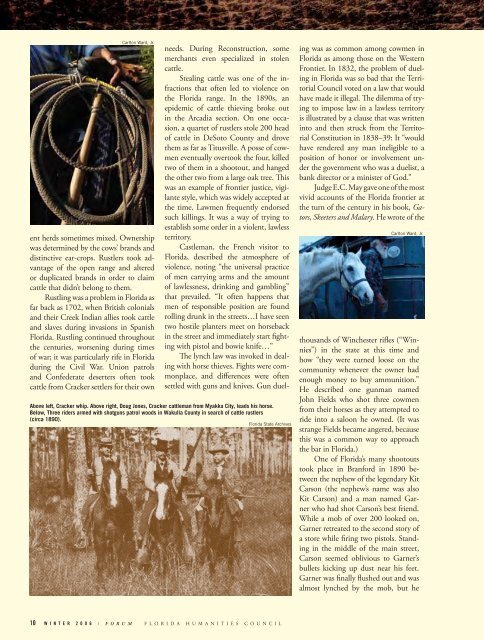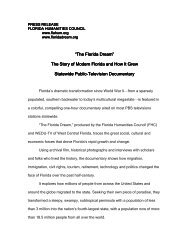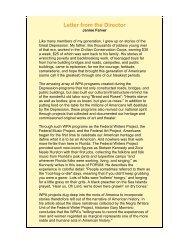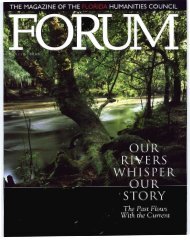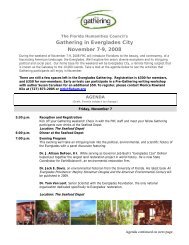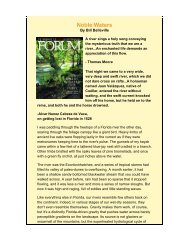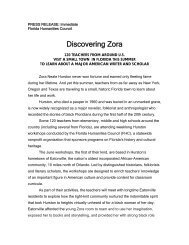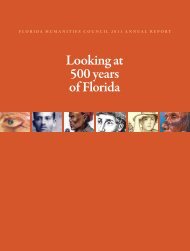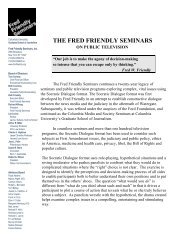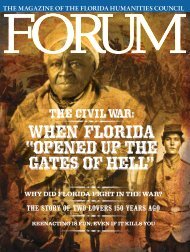THE MAGAZINE OF THE FLORIDA HUMANITIES COUNCIL
THE MAGAZINE OF THE FLORIDA HUMANITIES COUNCIL
THE MAGAZINE OF THE FLORIDA HUMANITIES COUNCIL
You also want an ePaper? Increase the reach of your titles
YUMPU automatically turns print PDFs into web optimized ePapers that Google loves.
Carlton Ward, Jr.<br />
ent herds sometimes mixed. Ownership<br />
was determined by the cows’ brands and<br />
distinctive ear-crops. Rustlers took advantage<br />
of the open range and altered<br />
or duplicated brands in order to claim<br />
cattle that didn’t belong to them.<br />
Rustling was a problem in Florida as<br />
far back as 1702, when British colonials<br />
and their Creek Indian allies took cattle<br />
and slaves during invasions in Spanish<br />
Florida. Rustling continued throughout<br />
the centuries, worsening during times<br />
of war; it was particularly rife in Florida<br />
during the Civil War. Union patrols<br />
and Confederate deserters often took<br />
cattle from Cracker settlers for their own<br />
needs. During Reconstruction, some<br />
merchants even specialized in stolen<br />
cattle.<br />
Stealing cattle was one of the infractions<br />
that often led to violence on<br />
the Florida range. In the 1890s, an<br />
epidemic of cattle thieving broke out<br />
in the Arcadia section. On one occasion,<br />
a quartet of rustlers stole 200 head<br />
of cattle in DeSoto County and drove<br />
them as far as Titusville. A posse of cowmen<br />
eventually overtook the four, killed<br />
two of them in a shootout, and hanged<br />
the other two from a large oak tree. This<br />
was an example of frontier justice, vigilante<br />
style, which was widely accepted at<br />
the time. Lawmen frequently endorsed<br />
such killings. It was a way of trying to<br />
establish some order in a violent, lawless<br />
territory.<br />
Castleman, the French visitor to<br />
Florida, described the atmosphere of<br />
violence, noting “the universal practice<br />
of men carrying arms and the amount<br />
of lawlessness, drinking and gambling”<br />
that prevailed. “It often happens that<br />
men of responsible position are found<br />
rolling drunk in the streets…I have seen<br />
two hostile planters meet on horseback<br />
in the street and immediately start fighting<br />
with pistol and bowie knife…”<br />
The lynch law was invoked in dealing<br />
with horse thieves. Fights were commonplace,<br />
and differences were often<br />
settled with guns and knives. Gun duel-<br />
Above left, Cracker whip. Above right, Doug Jones, Cracker cattleman from Myakka City, leads his horse.<br />
Below, Three riders armed with shotguns patrol woods in Wakulla County in search of cattle rustlers<br />
(circa 1890).<br />
Florida State Archives<br />
1 10 WWI IN NT TE ER R 2 20 0 06 6 / / FFOO RRUU M FFLL O ORRI I D DA A H U M MAA N NI ITTI IEES S CC O U N NCCI ILL ing was as common among cowmen in<br />
Florida as among those on the Western<br />
Frontier. In 1832, the problem of dueling<br />
in Florida was so bad that the Territorial<br />
Council voted on a law that would<br />
have made it illegal. The dilemma of trying<br />
to impose law in a lawless territory<br />
is illustrated by a clause that was written<br />
into and then struck from the Territorial<br />
Constitution in 1838–39: It “would<br />
have rendered any man ineligible to a<br />
position of honor or involvement under<br />
the government who was a duelist, a<br />
bank director or a minister of God.”<br />
Judge E.C. May gave one of the most<br />
vivid accounts of the Florida frontier at<br />
the turn of the century in his book, Gators,<br />
Skeeters and Malary. He wrote of the<br />
Carlton Ward, Jr.<br />
thousands of Winchester rifles (“Winnies”)<br />
in the state at this time and<br />
how “they were turned loose on the<br />
community whenever the owner had<br />
enough money to buy ammunition.”<br />
He described one gunman named<br />
John Fields who shot three cowmen<br />
from their horses as they attempted to<br />
ride into a saloon he owned. (It was<br />
strange Fields became angered, because<br />
this was a common way to approach<br />
the bar in Florida.)<br />
One of Florida’s many shootouts<br />
took place in Branford in 1890 between<br />
the nephew of the legendary Kit<br />
Carson (the nephew’s name was also<br />
Kit Carson) and a man named Garner<br />
who had shot Carson’s best friend.<br />
While a mob of over 200 looked on,<br />
Garner retreated to the second story of<br />
a store while firing two pistols. Standing<br />
in the middle of the main street,<br />
Carson seemed oblivious to Garner’s<br />
bullets kicking up dust near his feet.<br />
Garner was finally flushed out and was<br />
almost lynched by the mob, but he


